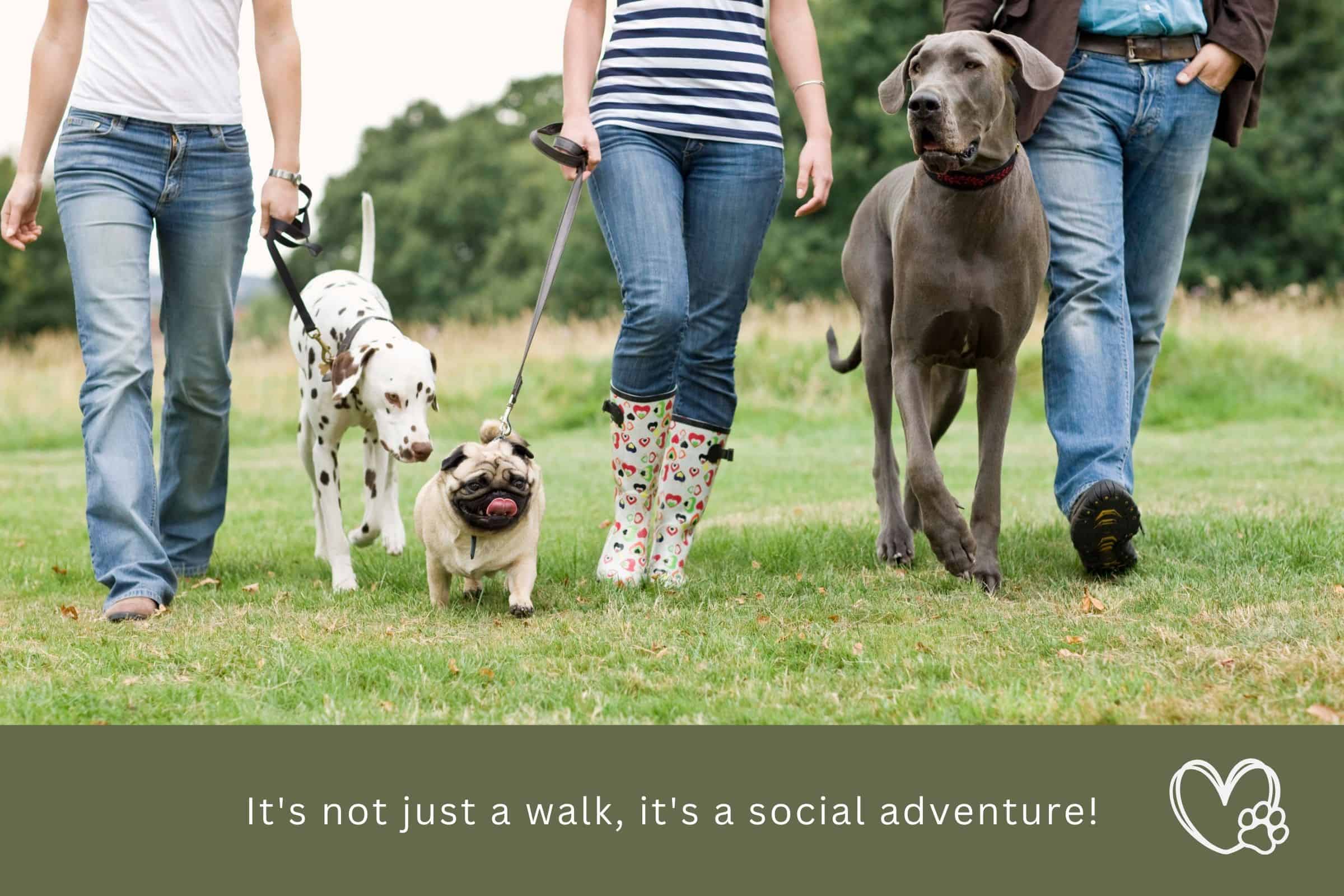This post may contain ads and affiliate links and we may earn a small commission when you click on the links at no additional cost to you. As an Amazon Affiliate, we earn from qualifying purchases. You can read our full disclaimer here.
Benefits of Daily Walks for Dogs: On the Move Walking Your Dog

Exploring the benefits of daily walks for dogs enhances their well-being and strengthens the bond you share with your pet.
As a dog owner, I have experienced the impact of regular strolls with my Goldendoodle and Golden Retriever. Although I must admit, we don’t go on walks as often as we should.
Life can get busy, making it challenging to find time for consistent dog walks. However, the rewards are undeniable. From improved health to better behavior, the benefits are significant.
Whether you’re new to dog ownership or looking to enhance your current routine, this guide is tailored to help you and your canine companion thrive.
An In-Depth Look at Benefits of Daily Walks for Dogs

Physical Health
The physical benefits of daily walks for dogs are extensive and crucial for their overall well-being. Regular walks are more than just a way to expend energy; they are a foundation for a healthy lifestyle.
By engaging in daily walks, dogs can maintain an ideal weight, improve their cardiovascular health, and enhance their muscle tone and joint mobility. This routine activity helps prevent numerous health issues that can arise from a sedentary lifestyle, such as obesity, diabetes, and arthritis.
These walks can significantly contribute to the longevity and quality of life of our canine companions.
Here’s a breakdown of these physical health benefits:
- Weight Management: Helps prevent obesity and maintain a healthy weight.
- Heart Health: Improves cardiovascular fitness and reduces the risk of heart disease.
- Joint Mobility: Increases flexibility and reduces the risk of joint issues like arthritis.
- Digestive Health: Aids in regular digestion and can help alleviate constipation.
- Overall Vitality: Boosts energy levels and enhances overall wellness.
Mental Stimulation

Mental stimulation is a key component of a dog’s health and happiness, greatly enriched by daily walks. These walks provide an opportunity for dogs to engage with the world around them, stimulating their senses in a way that indoor environments cannot match.
They encounter new scents, sights, and sounds, which encourages mental alertness and curiosity. This sensory enrichment is essential for their cognitive development and can help prevent issues like anxiety and depression.
Regular mental stimulation through walks is also linked to improved behavior, as it reduces tendencies for destructive behaviors that often stem from boredom.
The following list elaborates on the mental stimulation benefits:
- Sensory Engagement: Exposure to new sights, smells, and sounds.
- Cognitive Health: Promotes alertness and cognitive functioning.
- Behavioral Improvement: Reduces boredom-related behaviors like chewing and digging.
- Emotional Well-being: Decreases anxiety and enhances overall mood.
- Curiosity and Learning: Encourages exploration and learning in new environments.
Socialization Benefits of Daily Walks for Dogs

Socialization is an essential aspect of a dog’s life, significantly influenced by daily walks. These walks allow dogs to interact with other dogs and people outside their immediate family, which is crucial for their social development.
Regular exposure to different environments, people, and other animals helps dogs learn appropriate social behaviors and reduces fear and aggression in new situations.
This exposure also helps in building their confidence and adaptability, making them more well-rounded and less prone to anxiety.
The social benefits of daily walks can be broken down as follows:
- Meeting New Friends: Opportunities to interact with other dogs and people.
- Reducing Fear and Aggression: Helps dogs become more comfortable in various situations.
- Building Confidence: Increases confidence in unfamiliar environments.
- Learning Social Cues: Teaches dogs to read and respond to social cues from others.
- Enhancing Adaptability: Helps dogs become more adaptable and less anxious in new settings.
Practical Walking Tips for Dog Owners
Creating a Routine
Establishing a consistent walking routine is crucial for both you and your dog. A regular schedule not only helps your dog anticipate and look forward to their walks, but it also ensures they get consistent physical activity and mental stimulation.
Here are some tips to build a solid walking routine:
- Set a Fixed Time: Choose a time of day that works well for both you and your dog, and try to stick to it.
- Consider Your Dog’s Needs: Different breeds and ages have varying energy levels and walking needs. For example, a young Border Collie might need more exercise than an older Bulldog.
- Start Slowly: If your dog isn’t used to regular walks, start with short outings and gradually increase the duration.
- Mix It Up: Keep walks interesting by varying the route or visiting different parks.
- Stay Consistent: Try to walk your dog at the same time each day to establish a routine.
Choosing the Right Gear
The right gear can make walks safer and more enjoyable for both you and your dog. From leashes to harnesses, it’s important to choose items that suit your dog’s size, breed, and walking style.
Here are some key points to consider:
- Leash Type: Standard leashes are great for well-behaved dogs, while retractable leashes offer more freedom but less control.
- Harness vs. Collar: Harnesses can provide more control and reduce strain on your dog’s neck, especially for breeds prone to respiratory issues.
- Weather-Appropriate Gear: In hot weather, bring water and consider booties to protect their paws from hot pavement. In cold or rainy weather, a dog coat or rain jacket can keep them comfortable.
- Reflective Gear for Safety: If you walk early in the morning or late at night, reflective gear or a light-up collar can help keep your dog visible.
- Carry Essentials: Always bring waste bags, and consider a portable water bowl for longer walks.
Remember, the key to a successful walking routine is understanding your dog’s unique needs and being prepared for various conditions.
With the right approach, walking can become a highly anticipated and enjoyable part of your day together.
The Challenge Side of Benefits of Daily Walks for Dogs
Time Management
Balancing a busy schedule while ensuring your dog gets enough exercise can be challenging. Here are some strategies to manage time effectively:
- Short but Frequent Walks: If a long walk isn’t feasible, several shorter walks throughout the day can be just as beneficial.
- Dog Walking Services: Consider hiring a dog walker or using dog walking services to ensure your dog gets their exercise.
- Community Help: Neighbors or family members might be willing to take your dog for a walk, especially if they have dogs themselves.
- Combine Activities: Try to combine your dog’s walk with other activities, like walking to a nearby store.
- Morning Routines: Incorporating a walk into your morning routine can be a refreshing start for both you and your dog.
Behavioral Issues
Dealing with behavioral issues during walks can be frustrating, but there are ways to manage them:
- Training for Leash Pulling: Utilize training techniques such as stopping when your dog pulls, to teach them to walk calmly.
- Desensitization and Counterconditioning: For dogs reactive to others, slowly and systematically expose them to their triggers in a controlled way.
- Use of Appropriate Gear: Tools like no-pull harnesses or head collars can help manage pulling.
- Professional Help: Don’t hesitate to seek help from a professional dog trainer or behaviorist.
- Consistency and Patience: Regular training and consistent responses are key in managing and improving behavioral issues.
Health Limitations
Walking dogs with health limitations requires special consideration:
- Consult Your Vet: Before starting any new exercise routine, especially for dogs with health issues, consult with your veterinarian.
- Short, Gentle Walks: For older dogs or those with health conditions, shorter, more gentle walks are advisable.
- Adapt to Their Pace: Let your dog set the pace, and be ready to stop and rest if they need to.
- Alternative Exercises: Swimming or gentle indoor play can be good alternatives for dogs unable to handle regular walks.
- Monitor for Signs of Discomfort: Always be vigilant for any signs of pain or discomfort during and after the walk.
Addressing these challenges can make walking a more enjoyable and feasible activity for both you and your dog, regardless of the circumstances.
Benefits of Daily Walks for Dogs: Engaging with Your Dog During Walks
Interactive Activities

Transforming walks into interactive and fun experiences can greatly enhance the enjoyment and engagement for both you and your dog.
Here are some ideas to spice up your regular walks:
- Hide and Seek: Use treats to play hide and seek, hiding them along the route for your dog to find.
- Fetch on the Go: If you have access to a safe, open space, incorporate a game of fetch into your walk.
- Obstacle Course: Use natural features like benches or low walls for a fun, impromptu obstacle course.
- Sniffing Games: Allow your dog to take ‘sniff breaks’ where they can freely explore scents.
- Change of Scenery: Occasionally, choose new and interesting environments to keep the walks exciting and unpredictable.
Training Opportunities
Walks are an excellent opportunity to reinforce training and obedience:
- Basic Commands: Practice basic commands like ‘sit’, ‘stay’, ‘come’, and ‘heel’ during quieter moments of the walk.
- Leash Manners: Use the walk to train your dog to walk calmly by your side, without pulling.
- Socialization Training: Gradually expose your dog to different people and animals, using positive reinforcement to encourage good behavior.
- Focus and Attention Games: Train your dog to maintain focus on you amidst distractions.
- Impromptu Tricks: Incorporate fun tricks like ‘spin’ or ‘shake’ during breaks in the walk.
By integrating these interactive activities and training opportunities, you not only enhance the physical benefits of walking but also contribute to your dog’s mental and behavioral development.
These activities can strengthen the bond between you and your pet, making each walk a rewarding experience.
Wrap Up of Benefits of Daily Walks for Dogs
In conclusion, daily walks offer a multitude of benefits for dogs, encompassing physical health, mental stimulation, and socialization. By understanding and implementing practical walking tips and overcoming common challenges, dog owners can ensure that these walks are as beneficial and enjoyable as possible.
Engaging with dogs through interactive activities and training during walks further enhances their value, making each outing an opportunity for growth and bonding.
Don’t forget, the goal is not just to walk but to enrich the lives of our canine companions in every step we take together.
-

Coffee Mug – In Dog Coffees I’ve Only Had One
$11.95 – $14.95 Select options This product has multiple variants. The options may be chosen on the product page
